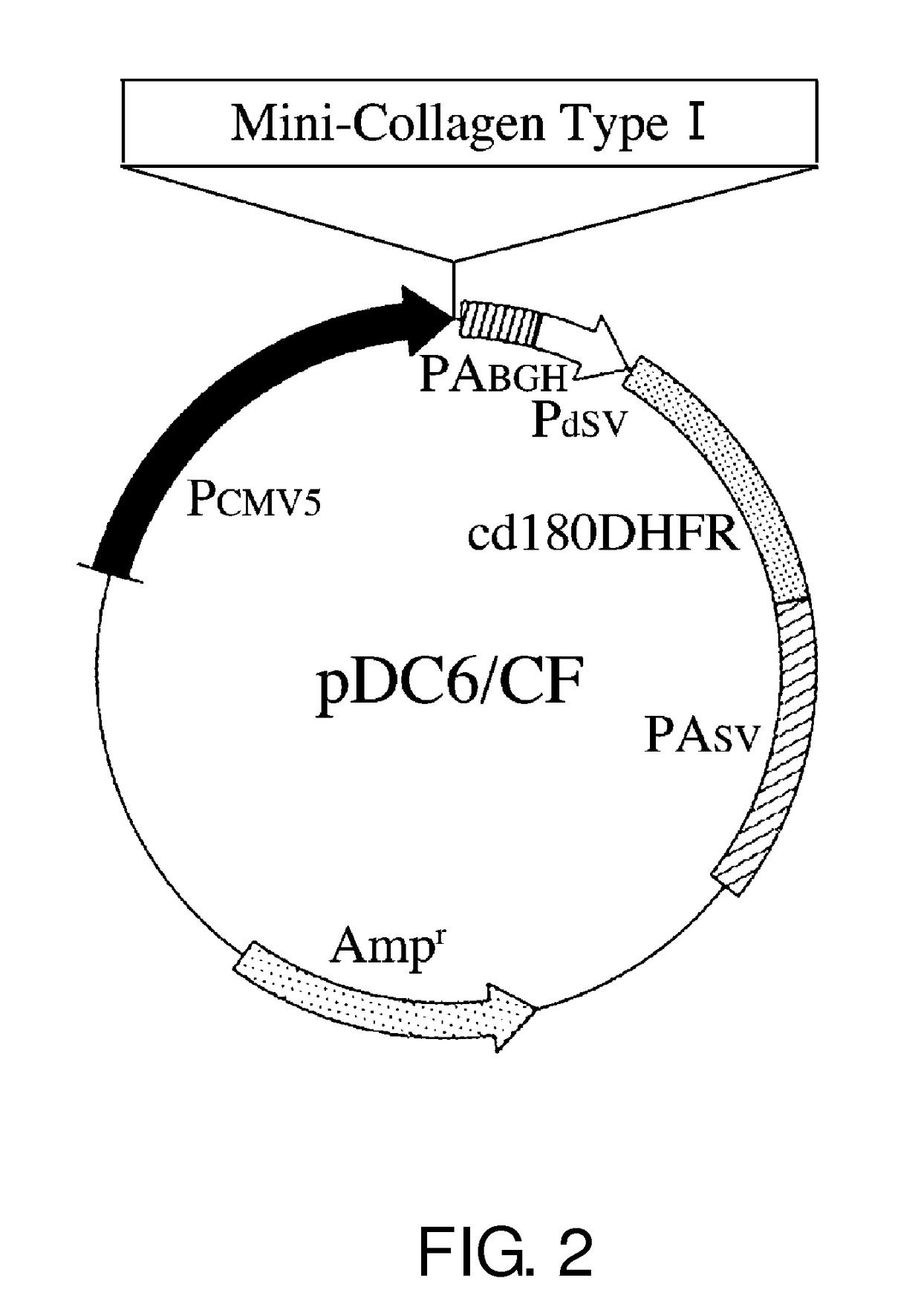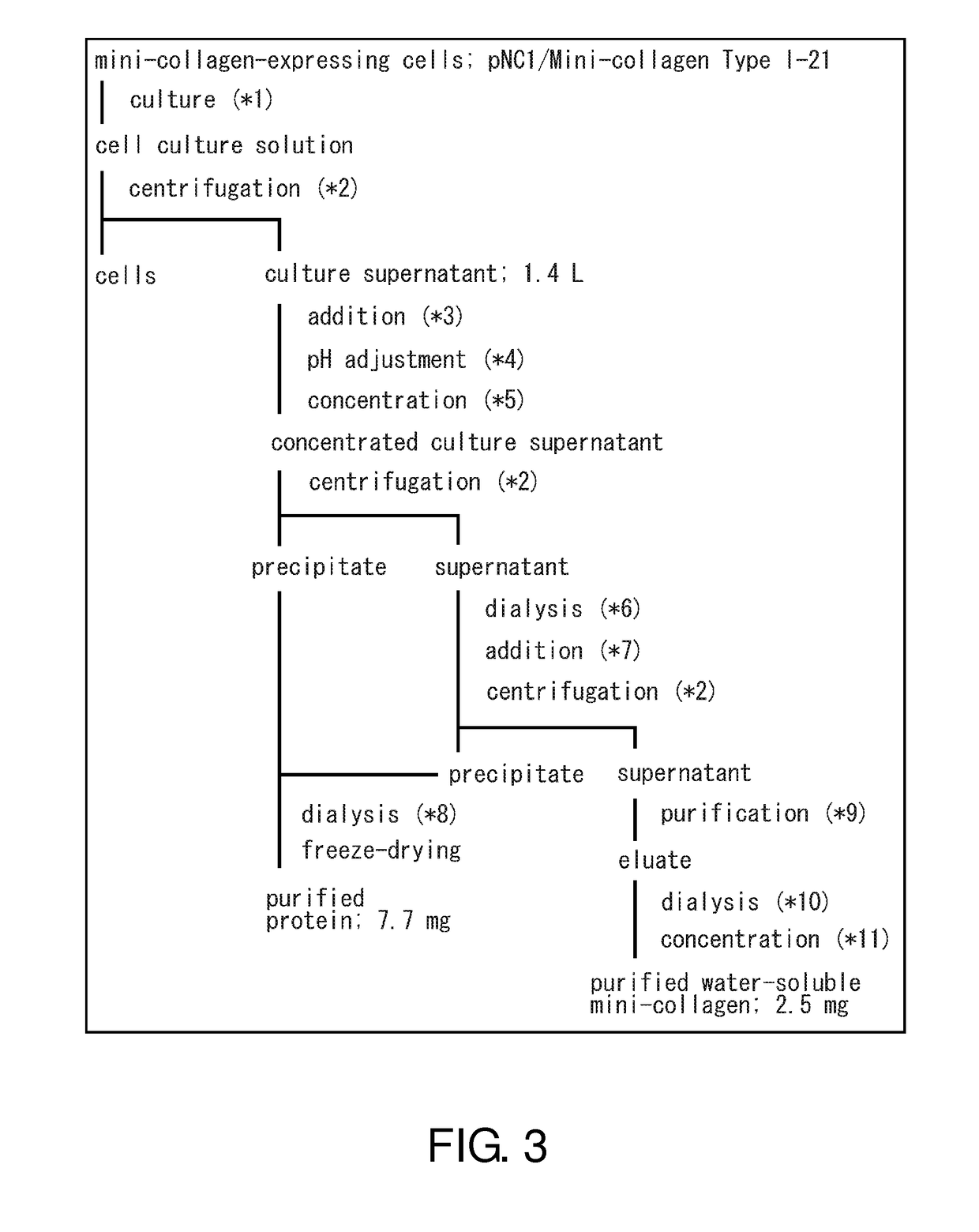Protein substance having triple helix structure and manufacturing method therefor
a technology of protein substance and triple helix, which is applied in the field of human-type collagen analogs, can solve the problems of major contamination risk of collagen derived from non-human mammalian species with prions or pathogens, and achieve the effects of low molecular weight, high purity, and easy purification
- Summary
- Abstract
- Description
- Claims
- Application Information
AI Technical Summary
Benefits of technology
Problems solved by technology
Method used
Image
Examples
example 1
Construction of pNC1 / Mini-Collagen Type I
[0137]Using methods well known to those skilled in the art, pNC1 / Mini-Collagen Type I (FIG. 1) was constructed by substituting nucleotide sequence No. 1274 of the pNC1 vector described in SEQ ID NO: 2 with the mini-collagen-encoding cDNA of SEQ ID NO: 3 (hereinafter described as Mini-Collagen Type I).
example 2
Introduction of pNC1 / Mini-Collagen Type I into CHO cells, and G418 Selection Using a CD Medium or a Medium Produced by Adding a Non-animal-based Additive to a CD Medium
[0138]10 μg of pNC1 / Mini-Collagen Type I was transfected into 5.0×105 CHO cells (CHO DG44 cells) in 25 cm2-culture flasks using the Lipofectin method (Lipofectamine™ LTX, Invitrogen was used). The transfection method followed the manufacturer's instructions. 48 hours after transfection, the cell number was determined, and then the cells were diluted in an IS CHO-CD w / Hydrolysate medium (IS Japan) containing 4 mM Gluta MAX™-I (Invitrogen). The cells were plated at concentrations of 1000 cells / well and 100 cells / well into five 96-well microtiter plates each for a total of ten plates (960 wells), and when cultured in the presence of 5% carbon dioxide gas at 37° C. for approximately three weeks, surviving cells were observed (G418-resistant clones). 72 G418-resistant clones were arbitrarily selected from the surviving ce...
example 3
Determination of the Mini-collagen Production Levels by pNC1 / Mini-Collagen Type I-transfected Clones
[0139]The production level was examined by ELISA. As indicated in FIG. 1, since mini-collagen contains a carbohydrate recognition domain of human MBL at its C terminal portion, human MBL antibodies were used for the detection of mini-collagen. Using 1 μg / mL of an anti-human MBL antibody (gift from Dr. Otani at Asahikawa Medical University, Japan) diluted with a coating buffer (15 mM, Na2CO3, 35 mM NaHCO3, 0.05% NaN3, pH 9.6), 96-well plates (F96 MAXI SORP Nunc-Immunoplate, Cat. no. 442404, Nunc) were coated at 4° C. for 16 hours. After blocking with 4% Block Ace (Dainippon Sumitomo Pharma Co., Ltd.), 100 μL each of culture supernatants 14 days after transfection (1 / 10 dilution), two-fold dilution series (20 to 0.3125 ng / mL) of purified human MBL (gift from Dr. Otani at Asahikawa Medical University) in IS CHO-CD w / Hydrolysate medium (IS Japan) which is a serum-free medium for CHO cell...
PUM
| Property | Measurement | Unit |
|---|---|---|
| flow rate | aaaaa | aaaaa |
| temperature | aaaaa | aaaaa |
| concentrations | aaaaa | aaaaa |
Abstract
Description
Claims
Application Information
 Login to View More
Login to View More - R&D
- Intellectual Property
- Life Sciences
- Materials
- Tech Scout
- Unparalleled Data Quality
- Higher Quality Content
- 60% Fewer Hallucinations
Browse by: Latest US Patents, China's latest patents, Technical Efficacy Thesaurus, Application Domain, Technology Topic, Popular Technical Reports.
© 2025 PatSnap. All rights reserved.Legal|Privacy policy|Modern Slavery Act Transparency Statement|Sitemap|About US| Contact US: help@patsnap.com



